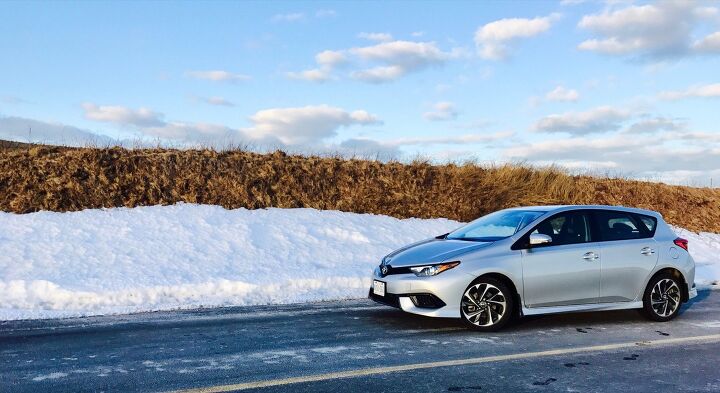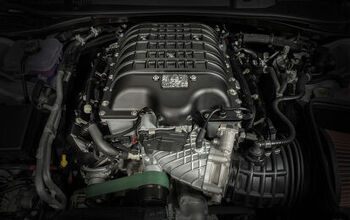This 2017 Toyota Corolla IM Is The Best Corolla, So Why Do 93% Of Corolla Buyers Choose The Sedan?
A year and a half since Scion introduced the iM in the United States, little more than a year since Toyota announced the Scion brand’s discontinuation, and six months since the Scion iM began to operate as the Toyota Corolla iM, almost every Toyota Corolla buyer chooses the inferior Corolla sedan instead of this hatchback.
Fortunately, the iM generates more sales activity for Toyota than it did for Scion. Over the last four months, for instance, the Corolla iM produced 6,548 U.S. sales, up 34 percent compared to the year-before figure claimed by the Scion iM.
After spending a week with the refreshed 2017 Toyota Corolla XSE sedan in January and the last week with the 2017 Toyota Corolla iM, it’s clear the iM is the superior Corolla. It’s clear that a far greater percentage of the 28,000 monthly American Corolla buyers should be choosing this car.
But they don’t. And they won’t. And there are a number of reasons why.
TTAC’s Steph Willems reviewed the 2017 Toyota Corolla iM less than two months ago, and there’s no point in attempting to hash out my differences with Steph in this case: there are few, if any.
It’s not handsome, but the iM features eye-catching sporty looks. “The climate control system’s toggle switches stirred inner fantasies of owning a World War 2 laboratory,” Steph wrote. Indeed, they are nice, though I’ve avoided such fantasies. The steering wheel doesn’t have nearly enough reach. The 137-horsepower 1.8-liter proudly resists acceleration. The steering is uncommunicative, but the Corolla iM handles decently and rides acceptably. In general, the Corolla iM looks like a Corolla hot hatch that isn’t hot. It’s a respectable machine, to paraphrase Steph, though not enthusiastic by any means.
Hardly the words of a ringing endorsement. Yet extensive time in both the Corolla and Corolla iM over a short period reveals four key ways in which the hatchback is more appealing than the sedan: steering, handling, load-lugging, and parking lot finding.
While not exactly full of feedback, the Corolla iM’s steering is much quicker to react than the steering in the regular Corolla. All Corollas use an electric power steering setup, but the sedan’s rack runs a 17.8:1 ratio with 3.19 turns lock-to-lock. The dead zone at the straight-ahead is disconcerting. In the Corolla iM, Toyota runs a 14.8:1 ratio; 2.59 turns lock to lock. Uncommunicative, yes. But not lifeless, thankfully.
Further to the iM’s dynamic appeal, there’s a double wishbone rear suspension in place of the Corolla’s torsion beam. You don’t need to be hustling around Laguna Seca at 10/10ths to appreciate the Corolla iM’s more composed mid-corner reactions.
With nearly 13 fewer inches of overall length, the 2017 Toyota Corolla iM provides 60-percent more cargo capacity. That’s before the greater flexibility of the rear liftgate is taken into account.
Moreover, Toyota sold just 26,050 iMs in the United States since September 2015, fewer than the number of Corolla sedans typically sold in a month. It’s not conventionally handsome. Hey, it may not even be unconventionally handsome. But we all deserve to find our cars in the grocery store parking lot. (And this is always a danger.)
As a result, the iM is a decidedly more enjoyable Corolla with which to spend time.
Better than a Volkswagen Golf? A Mazda 3 5-Door? A Honda Civic Hatchback?
No.
But you’re a Corolla buyer. And this is the better Corolla.
Chances are, however, most Corolla buyers won’t give the Corolla iM a chance. The Corolla sedan swallows up all the oxygen in Toyota showrooms, for starters, just as it always has. Second, American car buyers continue to favor sedans, and Toyota continues to stock the company’s inventory to reflect that fact. Plus, the iM can only be built the way Toyota wants to build it, not the way you want it.
“The Corolla’s long heritage, reputation for quality, and reliability, and buyer loyalty has a lot to do with its popularity,” Toyota spokesperson Sam Butto told TTAC earlier this week.
The iM has no such heritage.
“The Corolla has a larger production capacity,” Butto says. “iM has only been around for a couple of years, compared to 50 for Corolla.”
Sedans also make up the vast majority of sales across most OEMs in this segment, Butto explained. Hatchbacks make up roughly one-fifth of Civic sales while earning a slightly larger share for the Ford Focus and approximately one-third of Mazda 3 volume.
And while Corolla iMs are technically available with a six-speed manual transmission — fewer than 1 percent of the 2,810 Corolla iMs in stock at Cars.com are manual-equipped — that’s one of only three ways you can truly change your Corolla iM. Pick one of six paint colours; pick your transmission, add navigation.
Mono-spec cars were the Scion way, but they’re not the Corolla way.
For the 2017 Toyota Corolla iM, therefore, this means no sunroof. No proximity access and pushbutton start. No power seat; no lumbar support. No leather. No heated seats. (Though our Toyota Canada-supplied press car does have bun warmers.)
The Corolla iM is a decently equipped car, to be fair. The steering wheel is leather wrapped. Toyota Safety Sense C, with pre-collision, auto high beams, lane departure alert, is standard kit. 17-inch alloys and body color exterior bits keep the iM from looking like a bare-bones econo-hatch.
But this is the 2017 Toyota Corolla iM you must buy if, in fact, you yearn for a Corolla iM.
Besides the historic strength of the Corolla nameplate sans iM, and the hatchback bodystyle limiting its American appeal, and the generally limited availability of the iM, the mono-spec trim is a key limiting factor.
Alas, 93 percent of Corolla buyers end up choosing the lesser car.
Timothy Cain is the founder of GoodCarBadCar.net, which obsesses over the free and frequent publication of U.S. and Canadian auto sales figures. Follow on Twitter @goodcarbadcar and on Facebook.
More by Timothy Cain
Latest Car Reviews
Read moreLatest Product Reviews
Read moreRecent Comments
- ToolGuy TG grows skeptical about his government protecting him from bad decisions.
- Calrson Fan Jeff - Agree with what you said. I think currently an EV pick-up could work in a commercial/fleet application. As someone on this site stated, w/current tech. battery vehicles just do not scale well. EBFlex - No one wanted to hate the Cyber Truck more than me but I can't ignore all the new technology and innovative thinking that went into it. There is a lot I like about it. GM, Ford & Ram should incorporate some it's design cues into their ICE trucks.
- Michael S6 Very confusing if the move is permanent or temporary.
- Jrhurren Worked in Detroit 18 years, live 20 minutes away. Ren Cen is a gem, but a very terrible design inside. I’m surprised GM stuck it out as long as they did there.
- Carson D I thought that this was going to be a comparison of BFGoodrich's different truck tires.





































Comments
Join the conversation
I was disappointed by the back seat room, but I would always choose the hatch over the sedan, always. If MURRICA drivers weren't so fixated on "fake off-roaders"...
I think hatchback design should recognize the practical aspect, as the Matrix did, and the Impreza does. (I owned a Matrix - very useful.) The steeply raked windshield and low roof make this thing difficult to get in and out of.